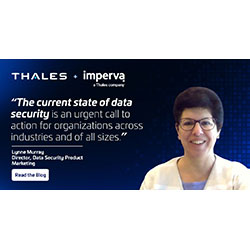Three Keys to Modernizing Data Security: DSPM, AI, and Encryption
andrew.gertz@t“¦
Tue, 01/21/2025 – 14:56

 Lynne Murray – Director of Product Marketing for Data Security
Lynne Murray – Director of Product Marketing for Data SecurityMore About This Author >
The perfect storm
Figure 1. GDPR cumulative sum of fines
(Source: enforcementtracker.com/?insights) A persistent skills gap lingers. As organizations strive to improve data security, a longstanding skills gap remains the most significant impediment. The Omdia study found that 64% of respondents cite a skills gap as the most substantial issue impacting the security function of their organization. Complex, disjointed security infrastructures are commonplace. In the organizational scramble to stay ahead of rapidly advancing cyber threats, multiple tools, duplicate efforts, and labor intensity have created complex, disjointed security infrastructures. This traditional piecemeal approach comes at a high cost, often increasing cyber vulnerabilities. Omdia identified a strong trend toward the adoption of a centralized, integrated security platform. Respondents indicate the top reasons are the need for scalability and flexibility (43%), improvements in the total cost of ownership (40%), better centralized management (40%), and the need to reduce complexity (37%).
Three keys to a future-forward data security strategy
1. A DSPM moves the needle with integrated capabilities and comprehensive encryption.

Figure 2: Percentage of sensitive data in the cloud
2. Embrace the strong shift toward unification with a platform-based approach.

Figure 3. Data security is a leading area
3. Leverage AI with the proper safeguards to reduce workloads and detect security threats.
Take action
- Look at DSPM capabilities to move the needle with integrated capabilities and comprehensive encryption. Embrace the shift toward unification with a platform-based approach. Leverage AI with the proper safeguards to reduce workloads and detect security threats.
Next steps
“@context”: “https://schema.org”,
“@type”: “BlogPosting”,
“headline”: “Three Keys to Modernizing Data Security: DSPM, AI, and Encryption”,
“description”: “Discover how DSPM, AI, and encryption are transforming data security strategies, reducing vulnerabilities, and improving compliance.”,
“author”: {
“@type”: “Person”,
“name”: “Lynne Murray”,
“url”: “https://cpl.thalesgroup.com/blog/author/lmurray”
},
“publisher”: {
“@type”: “Organization”,
“name”: “Thales Group”,
“description”: “The world relies on Thales to protect and secure access to your most sensitive data and software wherever it is created, shared, or stored. Whether building an encryption strategy, licensing software, providing trusted access to the cloud, or meeting compliance mandates, you can rely on Thales to secure your digital transformation.”,
“url”: “https://cpl.thalesgroup.com”,
“logo”: “https://cpl.thalesgroup.com/sites/default/files/content/footer/thaleslogo-white.png”,
“sameAs”: [
“https://www.facebook.com/ThalesCloudSec”,
“https://www.twitter.com/ThalesCloudSec”,
“https://www.linkedin.com/company/thalescloudsec”,
“https://www.youtube.com/ThalesCloudSec”
]
},
“datePublished”: “2025-01-21”,
“mainEntityOfPage”: “https://cpl.thalesgroup.com/blog/data-security/three-keys-modernizing-data-security-dspm-ai-encryption”,
“image”: “https://cpl.thalesgroup.com/sites/default/files/content/blog/images/lynne-murray-omdia-report-social.jpg”
}
First seen on securityboulevard.com
Jump to article: securityboulevard.com/2025/01/three-keys-to-modernizing-data-security-dspm-ai-and-encryption/
![]()

